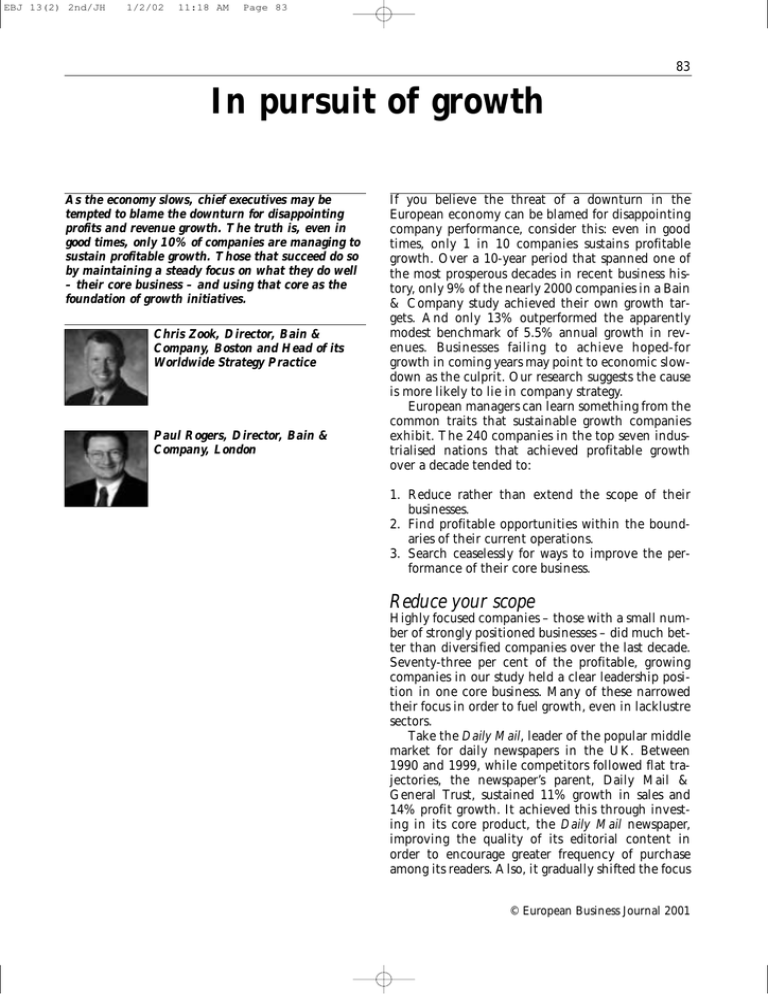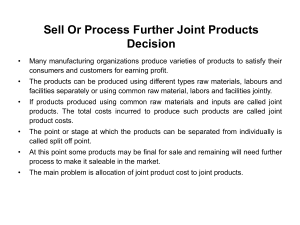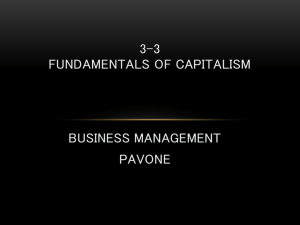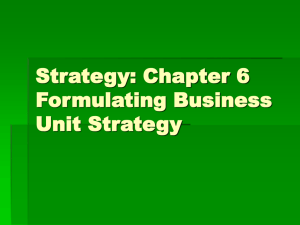In pursuit of growth 83 European economy can be blamed for disappointing
advertisement

EBJ 13(2) 2nd/JH 1/2/02 11:18 AM Page 83 83 In pursuit of growth As the economy slows, chief executives may be tempted to blame the downturn for disappointing profits and revenue growth. The truth is, even in good times, only 10% of companies are managing to sustain profitable growth. Those that succeed do so by maintaining a steady focus on what they do well – their core business – and using that core as the foundation of growth initiatives. Chris Zook, Director, Bain & Company, Boston and Head of its Worldwide Strategy Practice Paul Rogers, Director, Bain & Company, London If you believe the threat of a downturn in the European economy can be blamed for disappointing company performance, consider this: even in good times, only 1 in 10 companies sustains profitable growth. Over a 10-year period that spanned one of the most prosperous decades in recent business history, only 9% of the nearly 2000 companies in a Bain & Company study achieved their own growth targets. And only 13% outperformed the apparently modest benchmark of 5.5% annual growth in revenues. Businesses failing to achieve hoped-for growth in coming years may point to economic slowdown as the culprit. Our research suggests the cause is more likely to lie in company strategy. European managers can learn something from the common traits that sustainable growth companies exhibit. The 240 companies in the top seven industrialised nations that achieved profitable growth over a decade tended to: 1. Reduce rather than extend the scope of their businesses. 2. Find profitable opportunities within the boundaries of their current operations. 3. Search ceaselessly for ways to improve the performance of their core business. Reduce your scope Highly focused companies – those with a small number of strongly positioned businesses – did much better than diversified companies over the last decade. Seventy-three per cent of the profitable, growing companies in our study held a clear leadership position in one core business. Many of these narrowed their focus in order to fuel growth, even in lacklustre sectors. Take the Daily Mail, leader of the popular middle market for daily newspapers in the UK. Between 1990 and 1999, while competitors followed flat trajectories, the newspaper’s parent, Daily Mail & General Trust, sustained 11% growth in sales and 14% profit growth. It achieved this through investing in its core product, the Daily Mail newspaper, improving the quality of its editorial content in order to encourage greater frequency of purchase among its readers. Also, it gradually shifted the focus © European Business Journal 2001 EBJ 13(2) 2nd/JH 1/2/02 11:18 AM Page 84 EUROPEAN BUSINESS JOURNAL of its readership to include higher-income individuals, making the paper more attractive to advertisers. The Daily Mail now commands 20% of the readership of UK popular dailies, but more than 30% of the advertising. Finally, Daily Mail has invested surplus cash in opportunities closely related to its core business. These include electronic access to Daily Mail content, and a Scottish edition of the paper that saw daily circulation in Scotland increase from 36 000 to 90 000 in 1995. Contrast Daily Mail’s fortunes with those of UKbased bookseller W H Smith. This company began in 1792 as a newspaper distributor in the London area. Its news-stand business quickly expanded to serve the needs of train travellers. In addition to the newspapers passengers needed for long, chilly journeys, Smith’s sold games, foot warmers and even rugs. Today W H Smith’s core still caters heavily to travellers, but its $3.5 billion in sales spans a large distribution business and well over one thousand stores of different types. During the 1990s, W H Smith found its core under attack from specialist booksellers Dillon’s and Waterstone’s. Its response was not to strengthen its core of meeting travellers’ needs, but to broaden its sights, adding new retail product lines such as toys, typewriters, music, do-it-yourself tools, and gifts. This move resulted in reduced sales per square metre and higher inventory, infrastructure and systems costs. After losing $310 million in 1996, new management arrived with a new strategy. W H Smith set out to return to the original view of W H Smith’s marketplace and business definition. It sold its stake in non-core areas such as The Wall (a US music retailer) and a majority stake in the Virgin Our Price megastore music chain. Proceeds from these sales fuelled further investment in the core business. In 1998, W H Smith purchased 230 UK news-stands from rival distributor John Menzies. The company still faces many challenges, but is now looking in the right direction for solutions. Look for opportunities within current boundaries Companies with a thorough understanding of what constitutes their core business are best placed to grow. Armed with a clear definition of competitors, customers and products you are better equipped to judge the value of opportunities both inside and outside the current boundaries of your operation. 84 This can be complicated, particularly in fast-changing business environments. For example, take the new business-to-business Internet exchanges, such as e-STEEL, that bring together large numbers of buyers and sellers with the aim of creating an efficient market. Are such companies brokers or auctioneers? Are they in the software business? Or are they providing value-added procurement services? The range of possible answers could lead such companies in very different directions as they grow. Consider Amazon.com. It first became known as an Internet-based discount bookseller, but now appears to be extending its business to encompass all consumer retail on the Web. Perhaps it believes its core strength lies in fulfilling online orders, whatever the product. Certainly, Amazon has done this better than other pure Internet retailers. But its strength against shopping mall giants like do-ityourself store Home Depot and electronics retailer Circuit City remains unproven. By competing against a series of leaders in strongly branded sectors such as power tools, cosmetics and consumer electronics, Amazon is spreading itself thin. According to Lehman Brothers, gross margins in these new areas are a meagre 9.3%. Meanwhile, Amazon’s core is vulnerable to attack – competitor Barnes & Noble is growing its online sales. As a result, analysts are asking whether Amazon has bitten off more than it can chew. Set high performance targets Even companies that are well placed to grow profitably sometimes miss their opportunity because they set their sights too low. Rather than setting aggressive growth targets for a successful core they assume the business has reached its potential and begin looking elsewhere for new opportunities. Many managers do not realise how profitable a leading position can be. In our survey spanning 33 industries, companies with strong leadership positions achieved 25% return on capital, compared with 14% return for those whose position was close to that of their competitors. In 1980, the commercial credit services core of Dun & Bradstreet Corporation was six times larger than its nearest competitor. It generated $56 million in profits, and had a healthy 11.2% operating margin. Managers thought it was in good shape. However, when a new chief executive and operating officer arrived, they determined that, though successful, the company was operating far below its full potential. By 1990, EBJ 13(2) 2nd/JH 1/2/02 11:18 AM Page 85 IN PURSUIT OF GROWTH after reinvesting an increased share of its profits, computerising its credit database and improving products and distribution, Dun & Bradstreet had doubled sales and grown profits to $269 million. By 1997, profits doubled again. Like Dun & Bradstreet in 1980, many companies under-exploit their core and do not reinvest sufficient profits to fuel growth. The top performing companies in our survey invested at a rate of 15.3%, nearly twice that of industry rivals. Reinvestment was the key to success for silicon chip manufacturer Intel. In the past 18 years, Intel has focused narrowly on producing digital logic chips for personal computers. It has reinvested the same proportion of profits in this core as rivals spread through multiple, diverse businesses. The result: Intel moved from being a number three player in 1980 to dominating the chip market, dwarfing competitors Advanced Micro Devices and National Semiconductor. Today, Intel ships more than 10 times as many units as both these rivals combined. 85 Pursue profitable growth Profitable growth is hard to achieve. The odds in the last decade were 10 to 1; this decade they may be worse. But you can improve your chances by taking a page from recent successes. Keep the focus of your business narrow, reducing scope if necessary to create a strong, profitable business. Define the boundaries of that business carefully, and understand its full potential. Then, set stretching targets and invest to achieve that potential. Do all of this before you step outside your core. When you do expand scope, move into areas that are closely related to your current business. This approach will make best use of your capabilities rather than spreading them too thin. References Zook C and Allen J (2001) Profit From The Core – Growth Strategy In An Era Of Turbulence. Maidenhead: McGrawHill.





